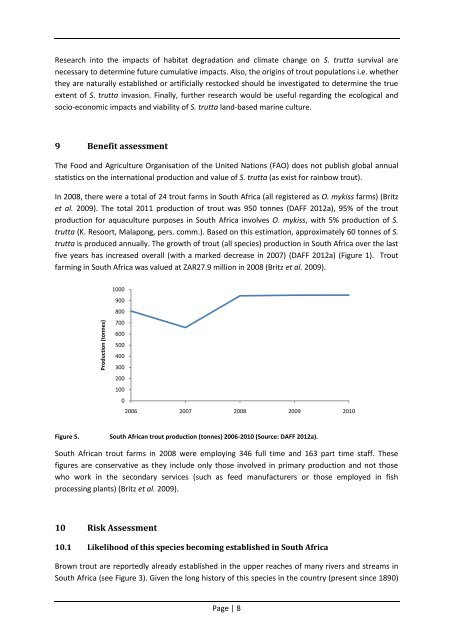Production (tonnes)Research into the impacts <strong>of</strong> habitat degradation <strong>and</strong> climate change on S. <strong>trutta</strong> survival arenecessary to determine future cumulative impacts. Also, the origins <strong>of</strong> <strong>trout</strong> populations i.e. whetherthey are naturally established or artificially restocked should be investigated to determine the trueextent <strong>of</strong> S. <strong>trutta</strong> invasion. Finally, further research would be useful regarding the ecological <strong>and</strong>socio-economic impacts <strong>and</strong> viability <strong>of</strong> S. <strong>trutta</strong> l<strong>and</strong>-based marine culture.9 Benefit assessmentThe Food <strong>and</strong> <strong>Agriculture</strong> Organisation <strong>of</strong> the United Nations (FAO) does not publish global annualstatistics on the international production <strong>and</strong> value <strong>of</strong> S. <strong>trutta</strong> (as exist for rainbow <strong>trout</strong>).In 2008, there were a total <strong>of</strong> 24 <strong>trout</strong> farms in South Africa (all registered as O. mykiss farms) (Britzet al. 2009). The total 2011 production <strong>of</strong> <strong>trout</strong> was 950 tonnes (DAFF 2012a), 95% <strong>of</strong> the <strong>trout</strong>production for aquaculture purposes in South Africa involves O. mykiss, with 5% production <strong>of</strong> S.<strong>trutta</strong> (K. Resoort, Malapong, pers. comm.). Based on this estimation, approximately 60 tonnes <strong>of</strong> S.<strong>trutta</strong> is produced annually. The growth <strong>of</strong> <strong>trout</strong> (all species) production in South Africa over the lastfive years has increased overall (with a marked decrease in 2007) (DAFF 2012a) (Figure 1). Troutfarming in South Africa was valued at ZAR27.9 million in 2008 (Britz et al. 2009).100090080070060050040030020010002006 2007 2008 2009 2010Figure 5.South African <strong>trout</strong> production (tonnes) 2006-2010 (Source: DAFF 2012a).South African <strong>trout</strong> farms in 2008 were employing 346 full time <strong>and</strong> 163 part time staff. Thesefigures are conservative as they include only those involved in primary production <strong>and</strong> not thosewho work in the secondary services (such as feed manufacturers or those employed in fishprocessing plants) (Britz et al. 2009).10 Risk Assessment10.1 Likelihood <strong>of</strong> this species becoming established in South Africa<strong>Brown</strong> <strong>trout</strong> are reportedly already established in the upper reaches <strong>of</strong> many rivers <strong>and</strong> streams inSouth Africa (see Figure 3). Given the long history <strong>of</strong> this species in the country (present since 1890)Page | 8
<strong>and</strong> the considerable effort that has been invested in facilitating spread around the country, thereare probably few areas where self sustaining populations could become established where they donot already exist.Nonetheless, the invasive potential <strong>of</strong> S. <strong>trutta</strong> in the twenty ecoregions <strong>of</strong> the country (Figure 4,Table 1) that do not meet the known basic physiological tolerance criteria <strong>of</strong> the species wasassessed in accordance with the European Non-Native Species Risk Analysis Scheme (ENSARS)developed by CEFAS (UK Centre for Environment, Fisheries & Aquaculture Science) (Copp et al.2008). ENSARS provides a structured framework (Crown Copyright 2007-2008) for evaluating therisks <strong>of</strong> escape, introduction to <strong>and</strong> establishment in open waters, <strong>of</strong> any non-native aquaticorganism being used (or associated with those used) in aquaculture. For S. <strong>trutta</strong>, 49 questions wereanswered, providing a confidence level <strong>and</strong> justification (with source listed) for each answer. Theresults <strong>of</strong> the assessment on S. <strong>trutta</strong> can be found in Appendix 1.The outcome <strong>of</strong> the scoring was that S. <strong>trutta</strong> should be further evaluated before introduction in thetwenty remaining ecoregions. However, this was a conservative score for general S. <strong>trutta</strong> farming,<strong>and</strong> accordingly, we have adapted this result with each different culture technique in mind (section12).10.2 Potential ecological impactsEscapees from aquaculture facilities are inevitable <strong>and</strong> occur worldwide unless appropriatemitigatory methods are applied. A relative <strong>of</strong> the brown <strong>trout</strong>, the rainbow <strong>trout</strong>, have been foundto travel up to 360 km following escape from aquaculture facilities, <strong>and</strong> have a 50% chance <strong>of</strong>survival, with some individuals surviving up to one year in the wild (Paterson 2010). Therefore, theimpacts <strong>of</strong> an introduction could potentially spread across an entire river catchment very rapidly.However, this study did not research the breeding potential <strong>of</strong> escaped fish so the impacts may onlybe transient.As there was no biological baseline survey done in South Africa in the 19 th century prior to the arrival<strong>of</strong> S. <strong>trutta</strong>, it is very challenging (as with many species) to accurately predict the impact <strong>of</strong> brown<strong>trout</strong> introductions (Bartley & Casal 1998).<strong>Brown</strong> <strong>trout</strong> are currently though to have had an impact (either through predation or competition)on at least three <strong>of</strong> the 50 South African fish species which are listed as threatened in the Red DataBook (Skelton 1987, Cambray 2003b). The presence <strong>of</strong> S. <strong>trutta</strong> <strong>and</strong> Oncorhynchus mykiss have beenimplicated in the decline <strong>of</strong> amphibian species, Hadromophryne natalensis, in uKhahlambaDrakensberg Park World Heritage Site (Karssing 2010). However, it is unclear whether thesepopulations <strong>of</strong> <strong>trout</strong> are the result <strong>of</strong> farm escapees or the intentional release by anglers.The risk <strong>of</strong> S. <strong>trutta</strong> hybridising with another indigenous species in South Africa is considered to bevery low. There is low risk <strong>of</strong> the brown <strong>trout</strong> hybridizing with other congenerics as there are nonative <strong>Salmo</strong>nidae in South Africa.High stocking densities commonly found in hatcheries can lead to outbreaks <strong>of</strong> parasites <strong>and</strong>diseases, if the hatchery design <strong>and</strong> management is not well maintained. Some <strong>of</strong> the parasitesPage | 9
















